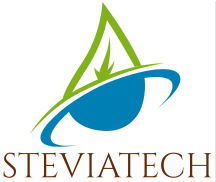The stevia plant is a small shrub, looks like Tulsi plant that has been used as sweetener for hundreds of years. This is also called “sweet-leaf, sugar-leaf or honey-leaf”. Because of its highly-potent sweetness, stevia is used as a zero- calorie sweetener in a variety of foods and drinks. The best-tasting, purified parts of the stevia plant – stevia leaf extract–is a great alternative to sugar, and it does not raise blood glucose levels, a concern for people with diabetes.
Known botanically as “Stevia Rebaudiana Bertoni,” the plant is native to Paraguay, grows well in tropical and sub-tropical locations. Today stevia is grown commercially all over the world where it flourishes underlong hours of daylight, plenty of water & warmth. In modern use, the stevia plant leaves are harvested and processed primarily for Extraction & Refining to make stevia – sweetener, also called stevia-sugar which are high intensity sweeteners and about250 to 350 times sweeter than cane-sugar.
Stevia grows best under tropical conditions, where major monthstemperature ranges between 15-42oC, and more than 10 hours of sunlight. Thestevia plant is native to South America.
Stevia is a sweetener extracted from the leaves of the plant Stevia, is unique and is mostvalued for what it doesn’t do. It doesn’t add calories. Unlike othersugar substitutes, stevia is derived from a plant. The active compounds of stevia are steviol glycosides, which have up to 200-300 times the sweetness of sugar, are heat-stable, pH-stable, and not fermentable.
Sugar consumption, especially from sugary drinks, is the single largest contributor to the global epidemic of diabetes, heart disease, high blood pressure, bad cholesterol, & unhealthy weight gain. Although several artificial sugar substitutes are available such as aspartame, saccharin, sucralose & cyclamates, etc., however many of them have critical concerns over the safety of health.
Global stevia market is rapidly increasing. In 2014, the global consumption ofstevia as food ingredient was estimated at 5,100 MT, and it has alreadyreachedabout 12,000 MT.
Yes. Refined sugar is virtually devoid of nutritional benefits and, at best,represents empty calories in the diet. At worst, it has been implicated innumerous degenerative diseases. Stevia is much sweeter than sugar and has noneof sugar’s unhealthy drawbacks.
Stevia powder is made from stevia leaves by grinding/pulverising the dry stevialeaves, and is green in colour. It has no industrial applications.
Stevia leaf extract, is made after industrially processing of dry stevia leaves byextraction and refining to produce high intensity stevia sweetener(HIS) or evenstevia-sugar. Technically known as steviol glycosides. It’s a whitefree flowingpowder about 200-350 times sweeter than sugar.
Stevia leaf extract is a high intensity natural sweetener that can be anywherefrom 200-350 times sweeter than sugar. You need to add only very small amountsto achieve the level of sweetness you expect with sugar. That’s part of why stevialeaf extract has no calories—you need very little.
Stevia leaf extract also has no calories due to the way your body metabolizes thesweetener—unlike sugar, stevia leaf extract quickly passes through your digestivetract and is eliminated without being broken down for calories. This can be abenefit for people trying to maintain a healthy weight and lifestyle.
Diabetes is a medical condition, which should be monitored and treated by aqualified physician or health care practitioner. However, stevia can be a part of ahealthy diet & diabetes management for anyone with blood sugar problems sinceit does not raise blood sugar levels.
Most certainly. However, sweeteners in general should be used in moderation in abalanced healthy diet. And artificial sweeteners should be avoidedaltogether.
Apparently not. Two tests conducted by Purdue University’s Dental ScienceResearch Group have concluded that stevioside is both fluoride compatible and”significantly” inhibits the development of plaque, thus stevia may actually helpto prevent cavities.
Absolutely! Industrial research in Japan has shown that stevia and steviosideextracts are extremely heat stable in a variety of everyday cooking and bakingsituations.
Raw herbal stevia contains nearly one hundred identified phytonutrients andvolatile oils, including trace amounts of Rutin (from the Callus) and B-Sitosterol(from the leaves). However, in the quantities typically consumed, the nutritivebenefits will be negligible. The extracts of stevia, beingrefined, willcontainfar fewer of these phytonutrients and volatile oils.
Green stevia powder would most likely impart colour to your food, dependingonhow much is used. However stevia leaf extract is mostly white and willgenerallyhave no effect on the colour of your food or beverage. The oneexception to thisrule could be baking, where you may notice colour and performancedifferenceswhen using stevia leaf extract as an ingredient.
Recent study in 2017; it has experienced that consuming stevia bring no change inblood chemistry, cellular function, compensation or appearance.
Stevia can easily grow in wide variety of soils any moderately sandy, loamy tomoderately clay soils with adequate drainage & aeration, but not heavy clay orsoil with poor drainage or saline soil.
Stevia grow best in temperatures 15-42oC with no frost. You can also easily growin higher temperatures with appropriate irrigation(sprinklers) facility for peaksummer days.
Crop need shallow and frequent irrigation 200-500ml per plant per day, withideal irrigation water pH range 6.0-7.0. Drip irrigation is the efficient way to dothis
Stevia tissue cultured plants and cuttings are commonly used as plantingmaterial. However they can be expensive. World-wide trend and practice adaptedfor commercial cultivation is by cutting which is developed in professionalnurseries from select variety mother plants. Propagation from seed is difficult,may give a lot of variation in production and sweetness content and not incommon practice.
Approx 32000-35000 plants per acre is recommended for Stevia.
Stevia crop remains productive for about 5 years if managed well.
The herbage can be harvested 3-5 times in a year depending on your geographicallocation and climates. The right harvesting time is when the leaves are matureand just before flowering starts.

